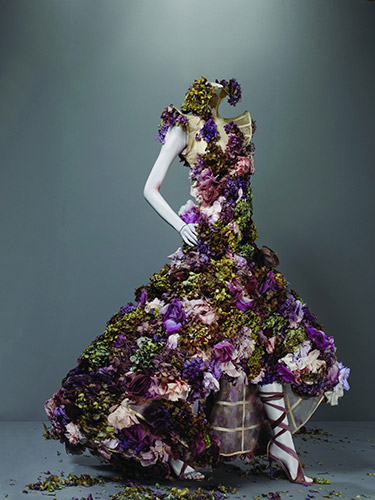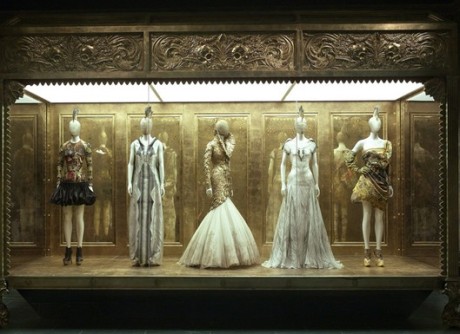Lifestyle Spotlight
Former First Lady Rosalynn Carter Passes Away at Age 96
Photos: Alexander McQueen: Savage Beauty Extends at Met through August 7

Alexander McQueen (British, 1969–2010), Corset, Dante, autumn/winter 1996–97, Lilac silk faille appliquéd with black silk lace and embroidered with jet beads, Courtesy of The Metropolitan Museum of Art, Photograph © Sølve Sundsbø/Art + Commerce
On Sunday afternoon, I stood in line for over an hour for the Alexander McQueen: Savage Beauty exhibition, the hottest ticket in town, in The Costume Institute at the Metropolitan Museum of Art. The breathtaking exhibition, on view in the Metropolitan Museum’s second-floor Cantor Galleries, features approximately 100 ensembles and 70 accessories from the late Mr. McQueen’s prolific 19-year career, and is a celebration of the fashion designer’s extraordinary contributions to fashion.
![11.McQueenAW2002-03OysterDress.L[1] Alexander McQueen (British, 1969–2010), “Oyster” Dress, Irere, spring/summer 2003, Ivory silk organza, georgette, and chiffon, Courtesy of The Metropolitan Museum of Art, Photograph © Sølve Sundsbø/Art + Commerce](http://liachang.files.wordpress.com/2011/05/11-mcqueenaw2002-03oysterdress-l1.jpg?w=375&h=500)
Alexander McQueen (British, 1969–2010), “Oyster” Dress, Irere, spring/summer 2003, Ivory silk organza, georgette, and chiffon, Courtesy of The Metropolitan Museum of Art, Photograph © Sølve Sundsbø/Art + Commerce
Since opening on May 4, Alexander McQueen: Savage Beauty has been drawing crowds, with the highest attendance of any public opening day for a Costume Institute exhibition; that attendance was second at the Met only to that of Vincent van Gogh: The Drawings in 2005. More than 180,000 people have seen the show. Set to close on July 31, the Alexander McQueen: Savage Beauty exhibition has been extended until August 7.

Alexander McQueen (British, 1969–2010), “Jellyfish” Ensemble, Plato’s Atlantis, spring/summer 2010, Dress, leggings, and “Armadillo” boots embroidered with iridescent enamel paillettes, Courtesy of The Metropolitan Museum of Art, Photograph © Sølve Sundsbø/Art + Commerce
Starting Monday, June 6, you can take advantage of Met Mondays with McQueen, with additional hours that the exhibition galleries will be open. Tickets for special viewings to see the exhibition on upcoming Mondays (when the Museum is closed to the public) between 9:30 am and 2:30pm are $50 per person, with entries on the half hour, and includes a free Audio Guide to the exhibition. Tickets are available on-site at the Met as well as on the Museum’s website at www.metmuseum.org/alexandermcqueen. (Met Mondays with McQueen is not offered on Monday, July 4, because it is a Met Holiday Monday, one of the annual series of Monday holidays when the Museum’s galleries are open to the public.) On Tuesdays through Sundays, through the run of the exhibition, Museum Members are provided express entry to the exhibition, allowing them to skip the lines to enter the exhibition.

Alexander McQueen (British, 1969–2010), Dress, VOSS, spring/summer 2001, Red and black ostrich feathers and glass medical slides painted red, Courtesy of The Metropolitan Museum of Art, Photograph © Sølve Sundsbø /Art + Commerce
A brilliant and comprehensive survey of his designs, Alexander McQueen: Savage Beauty begins with his Central Saint Martins postgraduate collection in 1992 and continues through to his final runway presentation, which took place after his death in February 2010. Drawn primarily from the Alexander McQueen Archive in London, with some pieces from the Givenchy Archive in Paris as well as private collections, signature designs including the bumster trouser, the kimono jacket, and the three-point “origami” frock coat are on view. McQueen’s fashions often referenced the exaggerated silhouettes of the 1860s, 1880s, 1890s, and 1950s, but his technical ingenuity always imbued his designs with an innovative sensibility that kept him at the vanguard.

Alexander McQueen (British, 1969–2010), Dress, Sarabande, spring/summer 2007, Nude silk organza embroidered with silk flowers and fresh flowers, Courtesy of The Metropolitan Museum of Art, Photograph © Sølve Sundsbø/Art + Commerce
“Alexander McQueen’s iconic designs constitute the work of an artist whose medium of expression was fashion,” said Thomas P. Campbell, Director of The Metropolitan Museum of Art. “This landmark exhibition continues the Museum’s tradition of celebrating designers who changed the course of history and culture by creating new possibilities.”

Alexander McQueen (British, 1969–2010), Ensemble, The Girl Who Lived in the Tree, autumn/winter 2008–9, Coat of red silk satin; dress of ivory silk chiffon embroidered with crystal beads, Courtesy of The Metropolitan Museum of Art, Photograph © Sølve Sundsbø/Art + Commerce
“Alexander McQueen was best known for his astonishing and extravagant runway presentations, which were given dramatic scenarios and narrative structures that suggested avant-garde installation and performance art,” said Andrew Bolton, Curator, The Costume Institute. “His fashions were an outlet for his emotions, an expression of the deepest, often darkest, aspects of his imagination. He was a true romantic in the Byronic sense of the word – he channeled the sublime.”

Alexander McQueen (British, 1969–2010), Dress, The Horn of Plenty, autumn/winter 2009–10, Black duck feathers, Courtesy of The Metropolitan Museum of Art, Photograph © Sølve Sundsbø/Art + Commerce
Six McQueen collections that explore his engagement with the Romantic sublime and the dialectics of beauty and horror are featured as groupings in the galleries – Highland Rape (autumn/winter 1995-96), Number 13 (spring/ summer 1999), VOSS (spring/summer 2001), Irere (spring/summer 2003), Plato’s Atlantis (spring/summer 2010), and Angels and Demons (autumn/winter 2010-11). “Cabinet of Curiosities” includes various atavistic and fetishized accessories produced in collaboration with the milliners Dai Rees and Philip Treacy, and the jewelers Shaun Leane, Erik Halley, and Sarah Harmarnee. The Cabinet also displays video highlights from ten of McQueen’s renowned runway presentations, including Joan (autumn/winter 1998–99), What a Merry-Go-Round (autumn/winter 2001–02), and They Shoot Horses Don’t They? (spring/summer 2004).

"The Romantic Mind" examines his technical ingenuity, which combined the precision of tailoring and patternmaking with the spontaneity of draping and dressmaking. Courtesy of The Metropolitan Museum of Art

Romantic Gothic and Cabinet of Curiosities: "Romantic Gothic" highlights McQueen's historicism, particularly his engagement with the Victorian Gothic, and dichotomies such as life and death. Courtesy of The Metropolitan Museum of Art.

"Romantic Nationalism" looks at McQueen's patriotic impulses, including his reflections on his Scottish heritage and his fascination with British history. Courtesy of The Metropolitan Museum of Art.

Alexander McQueen (British, 1969–2010), Ensemble, VOSS, spring/summer 2001, Jacket of pink and gray wool bird’s-eye embroidered with silk thread; trouser of pink and gray wool bird’s-eye; hat of pink and gray wool bird’s-eye embroidered with silk thread and decorated with Amaranthus, Courtesy of The Metropolitan Museum of Art, Photograph © Sølve Sundsbø/Art + Commerce
“Romantic Exoticism” explores the influence of other cultures on the designer’s imagination, especially China and Japan.

"Romantic Primitivism" captures McQueen's engagement with the ideal of the "noble savage." Courtesy of The Metropolitan Museum of Art

Plato's Atlantis - "Romantic Naturalism" considers his enduring interest in raw materials and forms from nature. Courtesy of The Metropolitan Museum of Art
Credits
The exhibition is organized by Andrew Bolton, Curator, with the support of Harold Koda, Curator in Charge, both of the Met’s Costume Institute. Sam Gainsbury and Joseph Bennett, the production designers for Alexander McQueen’s fashion shows, serve as the exhibition’s creative director and production designer, respectively. All head treatments and masks are designed by Guido. The graphic design of the exhibition is by Sue Koch of the Museum’s Design Department.
Related Programs
A book, Alexander McQueen: Savage Beauty by Andrew Bolton, accompanies the exhibition. It features a thematic overview of Mr. McQueen’s career, with an introduction by Susannah Frankel, fashion editor of The Independent, and an interview by Tim Blanks with Sarah Burton, creative director for Alexander McQueen, who worked closely with the designer for 14 years. It features new photography by Sølve Sundsbø, who shot ensembles from the McQueen archive on live models, then retouched the images to make them look like mannequins. The images combine the movement of an editorial shoot with the authority of a museum catalogue. Quotes from Alexander McQueen, exhaustively researched by Bolton, are paired with the images to enhance understanding of the designer’s viewpoint. A lenticular cover image was designed by McQueen for the invitation to his spring/summer 2009 fashion show. The book ($45 for a hardcover) is published by The Metropolitan Museum of Art and distributed worldwide by Yale University Press.
An audio tour, narrated by Andrew Bolton, provides additional insight into the exhibition via interviews with 16 of McQueen’s collaborators and friends including Sarah Burton, Naomi Campbell, Shalom Harlow, Shaun Leane, Annabelle Neilson, Sarah Jessica Parker, and Philip Treacy. It is available for rental ($7, $6 for members, and $5 for children under 12).
A series of gallery talks explore the art and literature that inspired McQueen’s designs. On June 19, Harold Koda and Aimee Mullins, the athlete and model who appeared in McQueen runway shows, discuss art, beauty, and the unique body. Fashion blogger Tavi Gevinson speaks and teens create wearable art inspired by the exhibition on June 11.
www.metmuseum.org/alexandermcqueen
Address
1000 Fifth Avenue at 82nd Street
New York, New York 10028-0198
Information: 212-535-7710
Hours
Tuesday–Thursday: 9:30 a.m.–5:30 p.m.
Friday and Saturday: 9:30 a.m.–9:00 p.m.
Sunday: 9:30 a.m.–5:30 p.m.
Admission
Fee includes same-day admission to the Main Building and The Cloisters Museum and Gardens. There is no extra charge for entrance to special exhibitions.
Recommended
Adults $20
Seniors (65 and older) $15
Students $10*
Members (Join Now) Free
Children under 12 (accompanied by an adult) Free
- Tags: Asian American Artists, Asian American Plays for a New Generation, AsianConnections_com, Backstage Pass with Lia Chang, Chinatown Beat, Chinatown Trilogy, Chinese American History, David Levien, Detective Jack Yu, Dr_ Julie Salzano, Entertainment, Henry Chang, Lia Chang, Literature, Lyndsay Faye, Meredith Anthony, Mid-Manhattan Library, Mu Performing Arts, Mystery Writers of America, mystery/crime, New York, NYPD, Red Jade, Rick Shiomi, THE EVIL MEN DO: Inside The Mind Of The Sexual Predator, Year of the Dog



